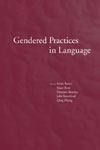

|
|
|
|

Gendered Practices in LanguageThis volume explores new themes in current research on language and gender. These include teasing out the boundaries between ideology and practice in language use, a focus on performativity, and analysis of how individuals use language to index socially important meanings in constructing their identity. The collection of articles is organized into five sections, each dealing with an aspect of gendered practices in language. Gendered norms of behavior and belief are maintained in part through policing language use. The papers in this section examine linguistic practices in school-aged peer groups, preschool classrooms, and in new technology development to show how they maintain and reinforce norms about how girls or boys, men or women should act and speak. The articles on gender bias illustrate ways in which institutions and implicit norms serve to distort or erase the perspectives and accomplishments of women. An example is Ryan's frame analysis of sexual assault judgments in Ireland, which provides clear, concrete linguistic evidence that existing discourses of gender constrain and construct interpretations of events in which sex is salient. A key part of the practice of norm reinforcement is linguistic ideology—how beliefs about language lead to the linking of a social group, category, or status with particular linguistic features or styles. In the section on ideology, analyses of Basque pedagogical practices, Japanese politeness norms, and Kenyan divination rituals, among others, bring to light the common processes of essentializing and naturalizing the link between gender and language use. Finally, two sets of cutting-edge work address the two related issues of individual agency and heterogeneity in actual practice. These sections question categorial normativity in terms of both theory and practice. They reveal how individuals make use of linguistic resources with independent social meanings, which are in turn gendered. In the section on agency and resistance, Sidnell's study of adolescent Guyanese males' use of habitual 'doz' links the variable to the construction of an independent, worldly identity, a stance that is more available to boys than to girls. Tetrault's analysis of “tom-boy talk” among Arabic-speaking adolescent girls in France shows how their use of competitive bragging, slang, and ritualized insults contributes to a strategic presentation of masculinity that helps secure their social position in the context of a low-income housing project. Such practices of resistance lead to heterogeneity within gender groups. The reality of heterogeneity in gendered language practice is evident in work such as Miyazaki's study of shifting pronoun use among Japanese schoolgirls, as well as in Bucholtz's study of new, hybrid forms of cyberfeminism, which attempt to reconcile geek identities with feminist stances. In sum, the volume as a whole draws together a wealth of perspectives on the intersection of language and gender, drawing out salient processes and practices ranging from institutional power to individual performance. , , , and were Ph.D. Candidates in Linguistics at Stanford University at the time of this publication. is Assistant Professor Linguistics at University of Texas at Austin.
Contents
9/1/2001 ISBN (Paperback): 1575863189 (9781575863184)
Subject: Language and languages--Sex differences; Sociolinguistics |
Distributed by the
University of Chicago Press |
|
pubs @ csli.stanford.edu
|
CSLI Publications
Stanford University Cordura Hall 210 Panama Street Stanford, CA 94305-4101 (650) 723-1839 |